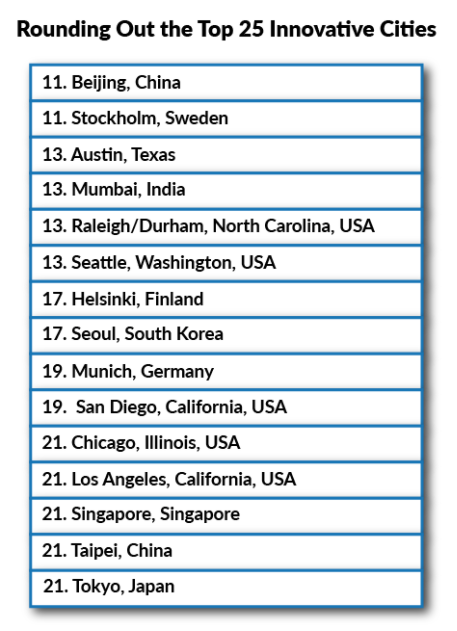This article was originally posted on Huffingtonpost.com
We live in an age of innovation, where the possibilities of sending humans to Mars, fundamental changes to our communications methods, emerging types of sentience, and our evolving relationships with money, both in business and recreation, are all undergoing advancements.
Innovation continues to be a tremendously powerful force for good, especially when the disruptions it causes are managed proactively. My company, Sappin Global Strategies (SGS), last looked at the most innovative cities in the world in late 2014. It’s time to revisit and revise, as the geopolitical and economic landscapes have changed substantially over the past three years.
SGS continues to focus on being quantitative and qualitative to determine where innovation is greatest. Startups and large companies, academia, even governments can be important areas of innovation. Our formula is based on these key criteria: how many patents are produced in a city/region, the composition of the local investor base, the education level of the workforce, job creation, what true innovations have grown and are growing locally / how effective the local infrastructure is in supporting innovation, and, last but not least, how many bona fide exits have occurred. All of these are ranked on a scale of 1 to 10 (1 being the best) to lead to an Innovation Score.
Some trends have accelerated while others have remained fairly constant. Highlights of the 2017 Most Innovation Cities of the World are:
Silicon Valley Remains the Heart of the Innovation Economy
- Silicon Valley still ranks at the top of our list. In spite of some overheating and persistently high valuations, the Bay Area is the place to be when it comes to innovation. This leader shows no signs of ceding its position on the global stage.
Big Cities are Proving Their Capacity to Innovate
- Big cities such as New York (static at #2) and London (entering at #9), more commonly associated with large companies, continue to drive their innovation economies. Significantly, both New York and London have made great strides in substantial exits, as well as creating lasting engines of innovation through public and private routes.
China Continues to be a Growing Force in Innovation
- China now places 3 of the top 10 cities, as companies such as Alibaba and Tencent, have gone public and/or have seen their market caps grow substantially and unicorns, such as Didi Chuxing, push their markets in China and look to expand beyond.

1. Silicon Valley/Bay Area
The Bay Area continues to impress. Although valuations have pulled back a bit over the past year, Silicon Valley is a leader in everything from AI to mobile to VR to biotechnology to clean energy. The Bay Area is a global leader in GDP per capita trailing only financial services hub Zurich and oil-rich Oslo. Its recent growth has even surpassed global heavyweight China.
2. New York
New York is best known as a corporate finance, legal, and media hub. While large companies have begun to innovate better, New York has also emerged as an incubator for companies such as WeWork (sharing economy), MongoDB (software), Etsy (consumer), Oscar (healthcare), and Infor(software). The 2017 IPO of Yext (location services) marked the largest New York IPO in several years, and according to at least one source in 2016, there were more than 100 exits of local companies.
3. Tel Aviv
Israel, particularly the Tel Aviv area, has long been a leader in innovation across technology, healthcare, water, and energy. From biotech heavyweight Teva to water technology leader IDE to software major AmDocs, Tel Aviv has shown an ability to consistently innovate and grow successful companies.
4. Hong Kong / Shenzhen
Hong Kong has long been a financial services haven, but with the emergence of mobile and internet heavyweight Tencent, the Pearl River Delta has firmly joined the ranks of global innovators. While there is still some debate on copycatting versus innovating, with large firms such as Huawei and ZTE(telecoms) and industry leaders such as DJI (drones), Hong Kong and Shenzhen, are setting the pace for innovation in China.
5. Boston
Route 128, with its proximity to MIT and Harvard, continues to be a front of innovation across healthcare, digital media, and energy. 2016 was a solid year for the local innovation economy companies such as Moderna Therapeutics (biotech) and DraftKings (gaming) raising substantial rounds and Padlock (biotech), Tensha (biotech) and CloudLock (cloud cybersecurity) having successful exits.
6. Bangalore
India’s innovation capital continues to come into its own with homegrown leaders such as Flipkart (E-commerce) and inMobi (mobile advertising). Also staking their claims on the unicorn list, global players such as Wiproand Infosys also continuing to evolve.
Bangalore has had a sharp uptick in exits and while some of its companies have hit rough patches as they go from startups to growth stage, the city is primed to continue to be the epicenter of innovation in South Asia.
7. (tie) Berlin
7. (tie) Hangzhou
7. (tie) London
7. (tie) Shanghai
Our top 10 wraps up with four cities tied in seventh place. Berlin has been a hotbed of entrepreneurial activity for years, becoming the go-to city for smart young Europeans. London, in spite of Brexit, has done a strong job of providing strong institutional support for startups and growth companies while leveraging the Oxbridge R&D nexus.
Hangzhou with Alibaba and Shanghai with Didi Chuxing and many other smaller companies, show the depth and breadth of China’s ability to develop global leaders (Alibaba) and outclass global leaders (Didi beating out Uber).

Beyond the top 10, let’s not forget the tremendous innovations and advancements happening in almost all corners of the globe. We live in very positive and interesting times when it comes to innovation. Empowering human capital on a world scale will continue to yield results for our lifetimes and beyond.
